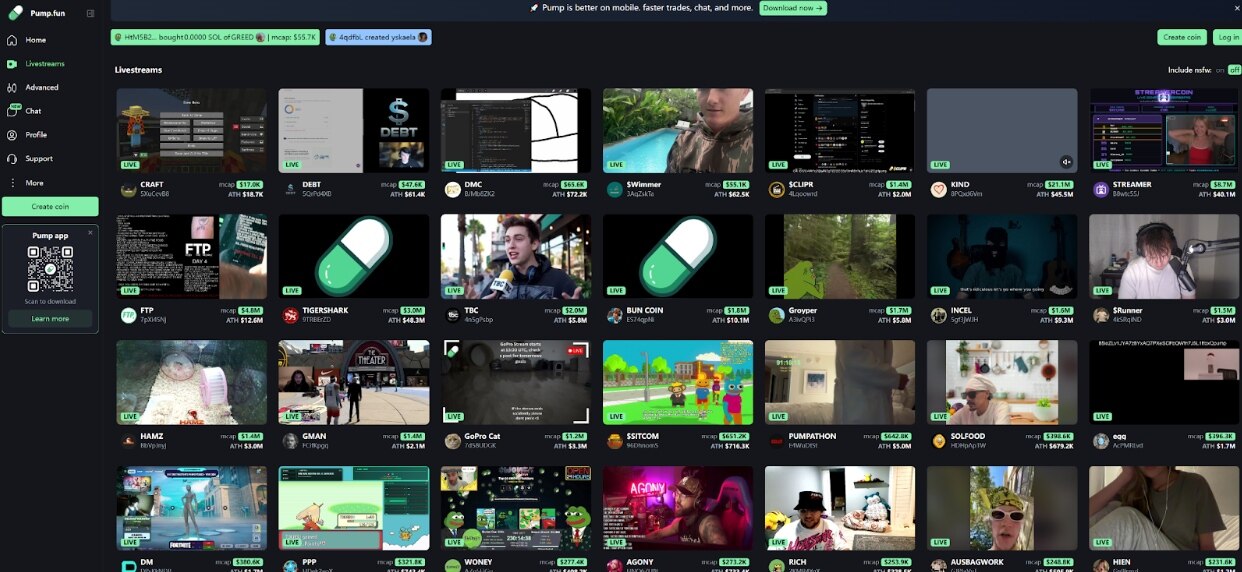After experiencing several cycles of bull and bear markets, the crypto world is entering a new experimental phase. Unlike the previous mainstream focus on financial instruments and on-chain infrastructure, more and more projects are now exploring lighter, more entertaining, and more socially-oriented new scenarios. This trend is particularly evident on Solana. With extremely low transaction costs and high on-chain performance, Solana is gradually becoming an incubator for the next generation of crypto products. Recently, Pudgy Penguins, Collector Crypt, and Pumpfun have garnered significant attention as three typical representatives.
Pengu: A Transformative Breakthrough from NFT Collectibles to IP Ecosystem
As the NFT market falls into a "winter," the traditional art trading model is losing its heat. In the face of this dilemma, Pudgy Penguins has chosen a completely different development path through its $PENGU token ecosystem: transforming NFTs into extendable intellectual property. Its core strategy is to evolve NFTs from static images stored in digital wallets into brand symbols that can truly reach the real world through careful image shaping, deep community operation, and diversified derivative product development. The ignition point of this IP value comes from the launch of physical toys, allowing consumers to seamlessly enter the on-chain constructed Pudgy World through QR codes on the toys. Parents think they are just buying an ordinary plush toy for their children, but unknowingly step into the world of Web 3. The recently launched Pudgy Party game continues this concept, as it does not prominently showcase blockchain technology or Web 3 elements, significantly lowering the entry barrier for users.

Source: Pudgy Party
This strategy disrupts the traditional business logic of NFT projects. Previous NFT game projects often followed a closed development path: project teams created additional value for holders based on existing NFT collectibles, enhanced community stickiness through gamified experiences, and ultimately launched functional tokens to complete the ecological loop. This model essentially serves an existing niche holder group, with user scales typically limited to a few thousand people. Pudgy Penguins has adopted a completely opposite market strategy, building a conversion funnel that penetrates from the mass market to the core community: creating game products with broad appeal → gaining large-scale user attention through quality content → converting game users into consumers of physical goods → ultimately guiding a small number of deep users into the NFT collectible field. The core of this strategy is to first occupy the mainstream mobile game market, establish brand recognition through entertainment content, and gradually introduce traditional internet users into the Web 3 ecosystem.
Regarding the $PENGU token, its positioning is more like the stock of the Pudgy ecosystem; investors purchasing it are essentially investing in the future development potential of this IP, rather than based on the token's utility. A series of market dynamics confirm the rationality of this value judgment: Canary Capital has submitted a groundbreaking PENGU/NFT-themed ETF application to the SEC, and Sharps Technology, a publicly listed company focused on Solana digital assets, has established a strategic partnership with Pudgy Penguins. These developments validate Pudgy Penguins' potential for breakthrough development as a seasoned project in the new era, showcasing a successful case of NFT projects transforming from mere NFTs to comprehensive IP brands.
Collector Crypt: Turning "Card Drawing Fun" into a Profitable Business
As the popularity of NFT collectibles wanes and pure digital narratives become lackluster, Collector Crypt ($CARDS) has not settled for a simple "putting cards on-chain" approach but has rebuilt the entire collectibles industry chain: transforming the massive offline TCG (trading card game) market into a "collectible finance" platform that integrates entertainment, finance, and high-frequency trading. Its core innovation lies in creating a standardized procurement and authentication system, combining gamified card-drawing mechanisms and tokenized investment channels, turning originally niche, low-frequency physical collectibles into highly liquid on-chain assets. Ordinary users do not need to become card experts to participate in the growth dividends of the entire collectibles track through the CARDS token. More cleverly, the platform has established a "drawing-recycling-repackaging" circular system, creating a sustainable business flywheel between entertainment consumption and capital flow. This approach disrupts the traditional RWA project's passive model of "custody on-chain, waiting for liquidity," instead adopting a proactive strategy of "supply-driven, operation-driven."
The power of this model comes from the organic combination of three key elements: a large-scale supply network, refined card-drawing operations, and tradable token exposure. The front end establishes a supply advantage through weekly auctions and direct purchases worth millions of dollars, ensuring the platform can acquire the rarest and most valuable card resources in the market; the back end guarantees capital circulation with an 85%-90% discount buyback, providing users with an exit mechanism and liquidity assurance; the middle uses a transparent probability mechanism and carefully designed prize pools to lower user entry barriers, making the card-drawing experience both exciting and fair. The result is transforming traditional collecting, a "slow business," into a "fast turnover" entertainment finance product, satisfying users' collecting pleasure and speculative psychology while building a robust unit economics model. Data shows that the platform's monthly sales have surged from millions to tens of millions of dollars, with a clear and sustainable profit model. While similar projects generally have not issued tokens, CARDS has become the only tradable asset in the market, with the team achieving comparable revenue scale with far lower financing than competitors, fully validating its execution capability and business efficiency. The platform is currently expanding from a focus on Pokémon to diversification, with categories like Magic: The Gathering (MTG) and sports star cards already in planning, indicating that CARDS is expected to upgrade from a "Pokémon platform" to a comprehensive collectibles liquidity center covering a market worth hundreds of billions of dollars.

Source: Collector Crypt
From One-Click Token Issuance to Live Streaming Finance: The Evolution of Pump.fun
Pump.fun is completely rewriting the "live streaming economy": first, it productized the "Launch Coin" process with one-click token issuance, lowering the barriers to creating tokens and standardizing meme issuance; now, it directly ties attention and token trading together, making fans not just viewers but co-owners of your "broadcaster coin." Each live stream corresponds to a token; the more active the audience is in buying and trading, the more you instantly earn creator fees from each transaction, with on-chain instant settlement and almost no intermediary cuts. The result is a tighter flywheel: content explosion → new wallets influx → trading volume surges → creator fees skyrocket → more motivation to produce the next wave of content. Cases have already emerged: broadcasters like "bagwork" earned about $150,000 in two days with a viral short video; meanwhile, public live streams like "Feed The People," which transparently donate their income, can quickly establish trust and retention using traceable on-chain fund flows.

Source: Pump.fun
Unlike the "slow monetization" of platforms like Twitch and YouTube (which rely on subscriptions/ads/brand deals, with high platform cuts, slow settlements, and algorithms favoring top creators), Pump.fun operates more like a real-time "attention market maker." Tokens turn fans' emotions, dissemination, and retention into a public scoreboard of price and liquidity: holders will spontaneously bring in new users, spread clips, and complete tasks; broadcasters can design fee sharing, lotteries, and ticket benefits, operating like a no-intermediary on-chain membership system. For creators, live streaming should be treated like running a startup: setting clear narratives and timelines, catalyzing weekly (collaborations, tasks, benefits), maintaining clean wallets and fair launches, and pushing through the "graduation" threshold to gain deeper liquidity and better pricing; for traders, a strategy manual is also taking shape—tracking surges in concurrent viewers, mentions on platform X, clip dissemination, Discord group joining, on-chain holder growth, and optimizing LP depth and distribution, trading with "narrative + data."
The essence of this transformation is merging the identity, emotions, and ownership of creators into pricing: your skills and stories are marketized in real-time, with fans and creators sharing the ups and downs and co-building the community. It will attract a large number of mid-tier and upper-tier streamers to migrate, as the returns are transparent, payments are instant, and platform risks are relatively lower (rules are written into contracts, fewer black boxes); however, it also comes with higher volatility and personal responsibility, necessitating clear community guardrails to prevent speculative noise from overwhelming content quality. Ultimately, attention has always been valuable, and Pump.fun simply makes it "more liquid, more programmable." Creators who can continuously generate "moments the internet cannot ignore," and traders who can read social + on-chain signals, will be best positioned to share in this wave of dividends; but please participate rationally and within your means. Risk warning: token prices are highly volatile, and related content does not constitute investment advice.
Paradigm Shift and Future Outlook of the Solana Ecosystem
From the IP breakthrough of Pudgy Penguins to the financialization reconstruction of Cards, and the creator economy revolution of Pump.fun, these three projects collectively outline the profound changes occurring in the Solana ecosystem, representing the inevitable trend of Web 3 moving from technical experimentation to mass application. Ultimately, attention has always been valuable, collectibles have always had worth, and IP has always been monetizable; these innovative projects on Solana simply make them "more liquid, more programmable, and more financially oriented." Creators who can continuously generate "moments the internet cannot ignore," product teams that deeply understand user needs, and participants who can read social and on-chain signals will be best positioned to share in this wave of dividends. However, while embracing innovation, we must also remain rational; these new models bring opportunities but also come with higher volatility and uncertainty. Whether participating in IP investments, collectibles trading, or creator tokens, it is essential to fully understand their risk characteristics and act within one's means. True value creation comes from deep insights into user needs and continuous product innovation, rather than short-term speculative hype.
免责声明:本文章仅代表作者个人观点,不代表本平台的立场和观点。本文章仅供信息分享,不构成对任何人的任何投资建议。用户与作者之间的任何争议,与本平台无关。如网页中刊载的文章或图片涉及侵权,请提供相关的权利证明和身份证明发送邮件到support@aicoin.com,本平台相关工作人员将会进行核查。




